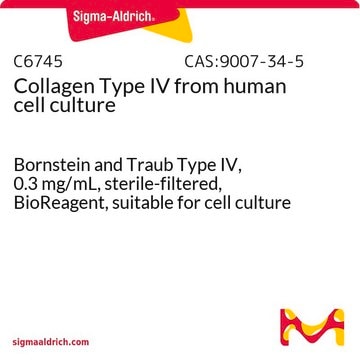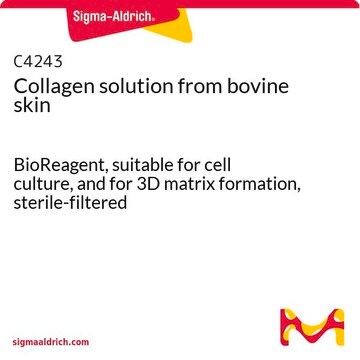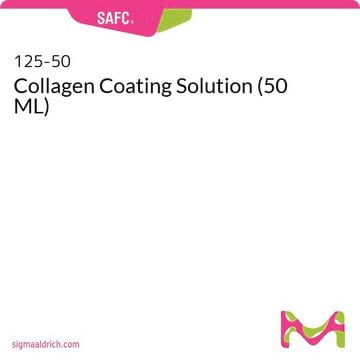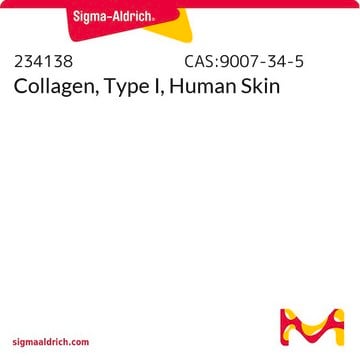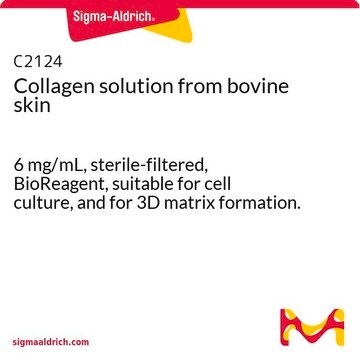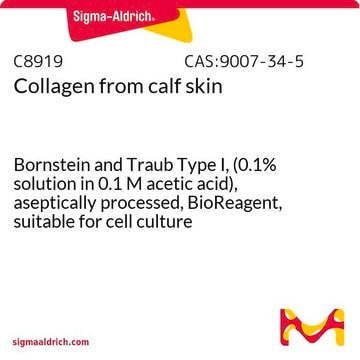As indicated above under 'PROPERTIES', this collagen solution is sterile-filtered.
C2249
Human Collagen Type I
from human fibroblasts, liquid, 3 mg/mL, suitable for cell culture
Sinonimo/i:
Collagen Solution, Fibroblast Collagen
Scegli un formato
Scegli un formato
About This Item
Prodotti consigliati
Nome del prodotto
Collagen Solution from human fibroblasts, 3 mg/mL, sterile-filtered, BioReagent, suitable for cell culture
Origine biologica
human fibroblasts
Livello qualitativo
Sterilità
sterile-filtered
Nome Commerciale
BioReagent
Stato
solution
Confezionamento
pkg of 20 mL
Concentrazione
3 mg/mL
tecniche
cell culture | mammalian: suitable
Copertura della superficie
6‑10 μg/cm2
Specificità del legame
Peptide Source: Collagen
Peptide Source: Elastin
Attività estranea
endotoxin ≤5.0 μmole/min-mg protein
Condizioni di spedizione
wet ice
Temperatura di conservazione
2-8°C
Descrizione generale
Applicazioni
Azioni biochim/fisiol
Codice della classe di stoccaggio
10 - Combustible liquids
Classe di pericolosità dell'acqua (WGK)
nwg
Punto d’infiammabilità (°F)
Not applicable
Punto d’infiammabilità (°C)
Not applicable
Scegli una delle versioni più recenti:
Possiedi già questo prodotto?
I documenti relativi ai prodotti acquistati recentemente sono disponibili nell’Archivio dei documenti.
I clienti hanno visto anche
Articoli
Extracellular matrix proteins such as laminin, collagen, and fibronectin can be used as cell attachment substrates in cell culture.
-
How did you steralize this collagen?
1 answer-
Helpful?
-
-
Is this product suitable for 3D gel formation? How should it be neutralized? How quickly does it polymerize once neutralized? Is there a protocol available for 3D gel formation?
1 answer-
Procedure for 3-D Gel Preparation:
1. Mix 8 parts of chilled collagen solution with 1 part of
10 X PBS (Catalog Number P5493 or P5368) or
10 X culture medium. Cells may be added following
this step.2. Adjust pH of mixture prepared in step 1 to 7.2–7.6.
Use of 0.1 M NaOH (10-fold dilution of Catalog
Number S2770) or 0.01 M HCl (100-fold dilution of
Catalog Number H9892) is recommended. Monitor
pH adjustment carefully with pH meter, phenol red,
or pH paper.3. To prevent gelation, maintain temperature of the
mixture at 2–8C. To form gel, warm to 37C. For
best results allow 45 minutes to 1 hour for gel
formation.4. The gels can be dried under a laminar flow hood.
Helpful?
-
-
What is the 2D Hydrogel protocol for Product No. C2249?
1 answer-
There has been no internal protocol for C2249 however this paper describes protocol for 2D Collagen Gel. Hong H, Stegemann JP. 2D and 3D collagen and fibrin biopolymers promote specific ECM and integrin gene expression by vascular smooth muscle cells. J Biomater Sci Polym Ed. 2008;19(10):1279-93. doi: 10.1163/156856208786052380. PMID: 18854122; PMCID: PMC2731795.
Helpful?
-
-
Is this a monomer?
1 answer-
This product is a mix of monomers, dimers, trimers, and oligomers, with some remaining collagen fragments.
Helpful?
-
-
What solvent is used for product C2249?
1 answer-
The solvent for product C2249 is 13 mM HCl.
Helpful?
-
-
Is the monomer a tropocollagen?
1 answer-
The human collagen is secreted from fibroblast cells, which cleave the loose ends of the procollagen molecule, leaving what is considered tropocollagen with the telopeptide region intact. An enzyme step is utilized to cleave the telopeptide, resulting in Atelocollagen, which maintains its triple helical formation but without the telopeptide region.
Helpful?
-
-
What is the acid, and concentration of acid, that the collagen is solubilized within?
1 answer-
The acid used to prepare this product is HCl. The final concentration of the solvent is 13 mM.
Helpful?
-
Active Filters
Il team dei nostri ricercatori vanta grande esperienza in tutte le aree della ricerca quali Life Science, scienza dei materiali, sintesi chimica, cromatografia, discipline analitiche, ecc..
Contatta l'Assistenza Tecnica.
